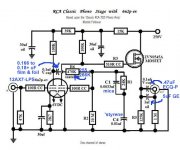Or you can go have a look for yourself, instead of asking someone else to do it. He gave you the clue, up to you to disprove it since that is clearly your intent.
Well, with some grain of salt. The nominal voltage drop at the PCC88 heater is 7 V, so it's a bit underheated with 6.3 V. Anyway, it will work in most cases.
Best regards!
Best regards!
The PCF802 is interesting. Its triode exhibits the same μ (amplification factor) as the 6SL7, while having lower plate resistance and higher transconductance (gm). A RCA style phono preamp is possible, using the PCF802 triode as the 1st gain block and the pentode as the 2nd gain block.
Build a current regulated 300 mA. DC supply for the series wired heaters. As pentode O/P impedance is high, buffering it is (IMO) essential. The DC coupled ZVN0545A source follower shown in the tweaked version of the 12AX7 RCA setup would be fine here too. RIAA EQ network parts values need to be recalculated and I suck at getting that right.
Build a current regulated 300 mA. DC supply for the series wired heaters. As pentode O/P impedance is high, buffering it is (IMO) essential. The DC coupled ZVN0545A source follower shown in the tweaked version of the 12AX7 RCA setup would be fine here too. RIAA EQ network parts values need to be recalculated and I suck at getting that right.
Attachments
I am also looking for a good EF184 preamp schematic. Triode curves are promising. The ECH84 triode should be usable as audio amplifier, but the PCF802 is a challenge because on most audio applications it would be required to pair it with another tube with 300mA heaters, and the resulting heater string voltage would probably be non standard.
The Kay Pirihna comment does not take in account the fact that reality is sometimes different than theory. PCC88 has been manufactured in many different ways. I tested about a hundred of PCC88 tubes that were pulled from discarded B&W TV sets. On the vast majority of them, the filament draws 300mA (the nominal value) at 6.3V. Those tubes are ECC88. They are not a slightly different variety, but a real ECC88 tube that has been stamped PCC88 instead. This does make sense, because most TV sets had filaments wired in series, and tube manufacturers had to find a way to sell those truckloads of seldom requested ECC88 tubes that sat in the warehouse. 0.7V difference is negligible on a series connected TV heater string.
The Kay Pirihna comment does not take in account the fact that reality is sometimes different than theory. PCC88 has been manufactured in many different ways. I tested about a hundred of PCC88 tubes that were pulled from discarded B&W TV sets. On the vast majority of them, the filament draws 300mA (the nominal value) at 6.3V. Those tubes are ECC88. They are not a slightly different variety, but a real ECC88 tube that has been stamped PCC88 instead. This does make sense, because most TV sets had filaments wired in series, and tube manufacturers had to find a way to sell those truckloads of seldom requested ECC88 tubes that sat in the warehouse. 0.7V difference is negligible on a series connected TV heater string.
Attachments
but the PCF802 is a challenge because on most audio applications it would be required to pair it with another tube with 300mA heaters, and the resulting heater string voltage would probably be non standard.
Freedom from all sorts of heater issues is why I favor DC coupled MOSFET source followers.
If 100% tubes in the signal path is desired, a 12AU7/ECC82 (for cathode followers) shared between the 2 channels would work in a PCF802 based phono preamp, that employs a 300 mA. series heater string. A LM350 adjustable regulator IC is surely stout enough for the task.
BTW, if additional linear medium μ voltage gain is desired in combination with PCF802s look at the Loctal 7AF7.
PCF802 may be used with 9V filament, there is no need to have it current limited. A 12 Volt winding and a series resistance 10 ohm 1w will do.I am also looking for a good EF184 preamp schematic. Triode curves are promising. The ECH84 triode should be usable as audio amplifier, but the PCF802 is a challenge because on most audio applications it would be required to pair it with another tube with 300mA heaters, and the resulting heater string voltage would probably be non standard.
The Kay Pirihna comment does not take in account the fact that reality is sometimes different than theory. PCC88 has been manufactured in many different ways. I tested about a hundred of PCC88 tubes that were pulled from discarded B&W TV sets. On the vast majority of them, the filament draws 300mA (the nominal value) at 6.3V. Those tubes are ECC88. They are not a slightly different variety, but a real ECC88 tube that has been stamped PCC88 instead. This does make sense, because most TV sets had filaments wired in series, and tube manufacturers had to find a way to sell those truckloads of seldom requested ECC88 tubes that sat in the warehouse. 0.7V difference is negligible on a series connected TV heater string.
- Home
- Amplifiers
- Tubes / Valves
- NOS TUBES

